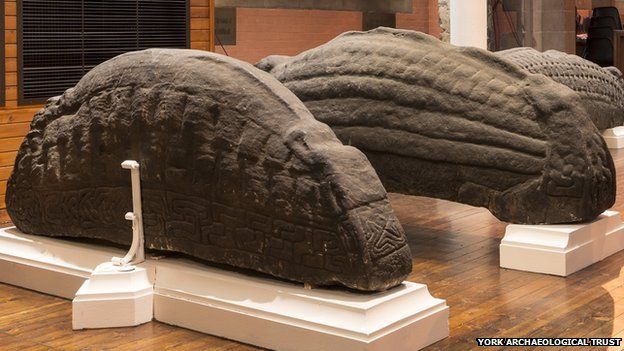 |
| Some stones in the Govan collection |
This area in Scotland was one of the earliest sites of Christianity in the surrounding country. These stones were not around until the ninth century CE (as early as c. 870 CE), and were made following the defeat of the Britons at Dumbarton. The Vikings laid siege to the Briton stronghold for four months before their victory. This victory allowed the Vikings to start settling throughout the surrounding countryside, though they mainly settle in the North. Many of these stones carry the common Scandinavian design of intricate interlace, scales, and weaved knot patterns; some even have dragon-like figures enveloping the ends of the stones. The patterns on the sides of the stones allude to the pagan roots of the Vikings, but their discovery inside a church yard suggests they had a more Christian meaning to those who created and placed the stones. The large Govan stones, weighing more than 1000 pounds, currently reside in the Old Govan Parish Church in Glasgow, Scotland.
References:
Brocklehurst, Steven. “Govan Stones: The Viking-Age Treasures.” BBC News, BBC, 27 Jan. 2014, www.bbc.com/news/uk-scotland-18172678.
“The Hidden Heritage of a Landscape.” Viking Research, 2013, hiddenheritage.org.uk/explore/viking-research/.
Walton, James. “Hogback Tombstones and the Anglo-Danish House: Antiquity.” Cambridge Core, Cambridge University Press, 2 Jan. 2015, www.cambridge.org/core/journals/antiquity/article/hogback-tombstones-and-the-anglodanish-house/A94935A5E0660727FF66BC3BB49EDD93.



Evan, this is a really in-depth post that I enjoyed! I thought it was interesting how you talked about how the pagan and Christian background of the Vikings is shown in these tombstones. I would also imagine that these 1,000 pound stones are not going to be moving anywhere.
ReplyDelete